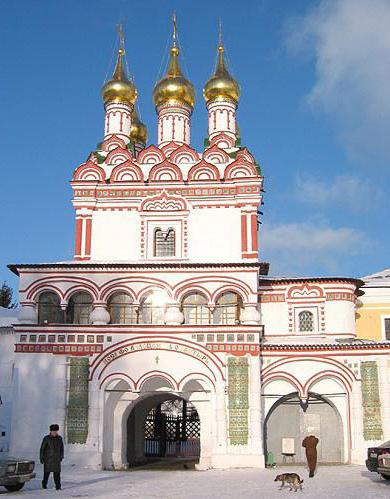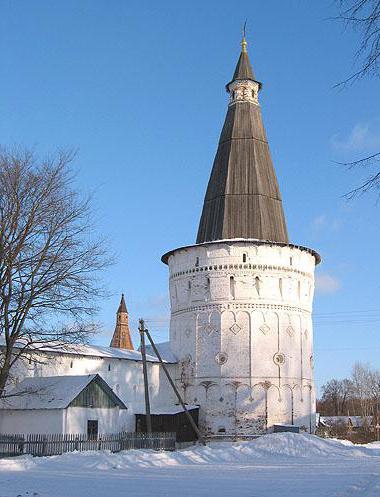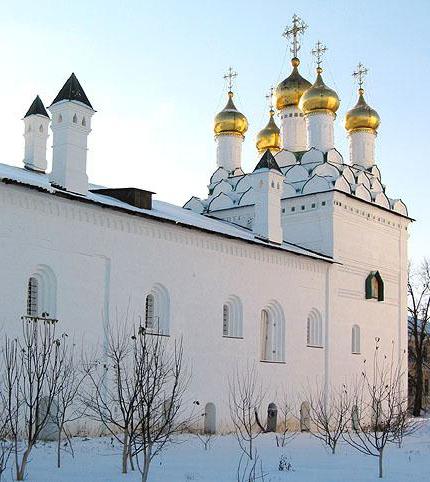The focus of this article will be the history and development of the Joseph-Volotsky Monastery. This ancient Orthodox monastery, which operates to this day, attracts not only numerous tourists, but also pilgrims. There are no locks in the Moscow region . But they are successfully replaced by fortified, impregnable-looking monasteries. Such is this object of pilgrimage and tourism. Joseph-Volotsky Monastery is built like a Kremlin. It is surrounded by powerful walls that can withstand the months-long siege of the enemy. After all, the monastery was erected in dashing and chaotic times. But today the monks of the monastery will welcome pious pilgrims and curious tourists. Unfortunately, the Second World War caused great damage to the historical buildings of the monastery. But little by little it is being restored. Let's take a virtual tour of the Joseph-Volotsky Monastery, and at the same time listen to his interesting story.
The base of the monastery
It all started with the fact that a certain Ivan Sanin felt a religious calling. He was tonsured a monk by Paphnutius Borovsky and took the monastic name Joseph. Sanin, who had died for the world, devoted himself to the service of God, and so succeeded in this that he became the successor of the Monk Paphnutius of the Mother Superior. Heading the community, Joseph tried to introduce a community-based charter into it. But the brethren categorically opposed this. Then the ascetic Joseph and another elder, Gerasim, went wandering around the hermitages and cloisters. But by 1478, Joseph returned to his native lands and asked permission from Boris Vladimirovich, Prince Volokolamsky, to establish a monastery for men. The Tombstone, compiled by Ivan Sanin's nephew Dosifei Toporkov, says the following: “The place for the monastery was indicated above. A column of dust spun around, and then lightning struck the earth in the clear sky. There the reverend put an end to it. ” So in 1479, the Joseph-Volotsky Monastery was founded .

Life of the saint
It is necessary to say a few words about the origin of the ascetic himself. Why did he have a conflict with his brotherhood and, most importantly, how did he find all secular support from the secular authorities (including material) for the construction of the Joseph-Volotsky Monastery? The noble family of Sanins owned the village of Yazvishche and was in the service of the specific prince Volotsky Boris. Ivan was not the only son. At the age of 20, he decided to take tonsure, and in 1459 went to the Tver Savvin Monastery. But he did not like the poverty of the monastery, and he moved to Borovsk. This monastery under the leadership of Paphnutius was famous for its wealth. In this monastery the ascetic spent 18 years. The monastery previously belonged to the Novgorod diocese. Having caught the desire of Grand Duke Ivan III to seize neighboring lands, Abbot Joseph comes into conflict with the Archbishop of Novgorod Serapion. Thus, the monastery passes into the Moscow diocese, which causes a murmur of the brethren. Despite the patronage of secular authorities, Joseph decided to leave and establish his own monastery. He was the godfather of the son of Boris Volotsky, Ivan of Ruzsky, and the confessor of the specific prince himself.
Joseph-Volotsky Monastery (Volokolamsk District, Moscow Region)
The support of secular authorities made it possible for the ascetic to rebuild the first wooden church of the monastery in just two months of the summer of 1479. Five years later, it was replaced by a stone cathedral. The monastery quickly takes the form of a Kremlin surrounded by powerful walls. There was also a prison for dissidents. Hegumen Joseph, elevated by the Orthodox Church to the rank of reverends, was an ardent persecutor of the Judaizers and defended the legality of possessing monasteries of worldly wealth, including land. He wrote that "... it is appropriate for heretics and infidels not only to condemn and hate, but to anathematize them and inflict wounds on them, sanctifying their hand with this ... Secular authorities must be put to death by their cruel execution." The messages of Joseph, discussing with non-possessors (in particular, with Neil Sorsky) that the monks may own lands and decorate temples with gold, have been preserved. The abbot died in 1515. Canonized in 1579. His followers, the Josephites, fiercely fought for the seizure of land and enslavement of the peasants in the seventeenth century. In 2009, Patriarch Kirill declared Joseph Volotsky the patron of entrepreneurship in Russian Orthodoxy.

Kremlin
The buildings of the Joseph-Volotsky Monastery are visible from afar. The golden domes of churches are shining , peering out from behind white walls with loopholes. Ponds were laid around the monastery. They not only blocked the path to a possible invader, but also replenished the monks' refectory with delicious fish. The fortress walls of the citadel monastery were rebuilt several times. The monastery successfully withstood the siege of the Polish-Lithuanian forces in 1612. The walls are designed for both ranged and melee. They are interspersed with towers. Each of them is a unique masterpiece of defense architecture. The most beautiful of them is considered Germanova. We come closer and see a monument erected in 2009 to the Monk Joseph Volotsky in front of the entrance. Behind him is seen a very elegant gateway church dedicated to the apostles Peter and Paul. It was built in 1679 in the Moscow Terem style. Let's go through the gate.

Buildings inside the monastery. Church of the Assumption of Our Lady
Even during the life of the Monk Hegumen of the Joseph-Volotsky Monastery, in 1486, a wooden stone church was built on the site. For her painting, the famous and venerable artist Dionysius was invited. When the fashion for Moscow Baroque came, this church was expanded and converted into a cathedral church. Its construction dates from 1688-1696 years. This five-domed temple impresses with its beauty and grandeur. Do not rush to go inside. First go around the cathedral. Outside, its walls are decorated with tiles, which were made in the seventeenth century in the workshop of the artist Stepan Polubes. Now let's go inside the temple. The icons painted by Dionysius did not disappear. They can be seen in the temple. The real decoration of the church is a five-tier carved iconostasis shining with gold. Information for pilgrims: in this church the relics and faiths of the most reverend Joseph are exhibited. In addition, the monastery is the tomb of the princes Volotsky, John and Fedor.
Other buildings on the territory of the monastery
The belfry of the Joseph-Volotsky Monastery was once especially famous. It was built in 1511 and adjoined the old temple. Then the bell tower neatly "fit" into the walls of the new cathedral. They say that in clear weather from its top you could see Moscow. But during the Great Patriotic War, Soviet troops, retreating, blew up the bell tower. Now its foundation is mothballed and awaits its restoration. What should I visit in the Joseph-Volovetsky monastery? Firstly, the already mentioned gate church. Next, look at the Hermann Tower from the other side. It is surrounded by Honey and White barns, as well as the monastery building with cells. In the refectory of the monastery, Joseph Volotsky himself dined. According to the plan, this architectural structure repeats the Faceted Chamber of the Moscow Kremlin - the arch rests on one pillar. The beautiful Corner Tower is also noteworthy.
Celebrity monastery
Unfortunately, there were no great cultural figures or Christian associates among the brethren, except for the founder of the monastery. But they languished in large numbers in the prison of the monastery. Among the most famous can be called the Monk Maxim the Greek, writer and religious leader, also canonized by the Orthodox Church. Prince Vasily Patrikeev, who took the monastic name of Vassian, as well as Vasily Kuritsyn and Matvey Bashkin - diplomats in the service of the Moscow Tsar - also languished in prison with Joseph Volotsky. They were objectionable to the reverend by openly talking about the need for non-covetousness. Their doctrine was declared by the cathedral of 1504 the heresy of the "Judaizers." The Volokolamsk Joseph-Volotsky Monastery became a prison for both Vasily Shuisky and a prominent figure in the church schism Gerasim Firsov.
Burials on the territory of the monastery
We have already mentioned that there is the tomb of the specific princes - the brothers John and Fyodor Borisovich. In addition, after the monastery was transferred to the Church in 1989, the relics of Joseph Volotsky were found. His chains were transferred to the cloister from the New Jerusalem Museum in Istra. The Joseph-Volotsky Stavropegial Monastery became the site of last reassurance for the Metropolitan Daniel, exiled here by Ivan the Terrible. The Novgorod Archbishop Theodosius is also buried here. Some well-known secular figures rest in the cemetery. This is Malyuta Skuratov, the head of the guardsmen, and the landowner of the village of Yaropolets N. Goncharova, who was the mother-in-law of A.S. Pushkin.
The new history of the monastery
Once there was a large library in the monastery, and from 1777 to 1823 there was a school for priestly sons. But most of all the monastery was known as a place of confinement. Its isolated location, powerful fortress walls made it possible to use the monastery as a prison. The dungeons of the monastery contained not only the personal enemies of the Rev. Hegumen Joseph Volotsky. At the beginning of the seventeenth century, Polish prisoners were kept here, and in 1812, French prisoners of war. After the October Revolution of 1917, the monastery was closed. From 1922 until 1989, an orphanage was located there.
Joseph-Volotsky Monastery: how to get there
This attraction of the Moscow region residents of the capital can visit in one day off. Getting to the Joseph-Volotsky Monastery is not so difficult, even if you use public transport for the trip. First you need to get to the village of Teryaevo. The Joseph-Volotsky Monastery is a kilometer away. There are two ways to get to Teryaevo. The first option: to get by train to Volokolamsk (Riga direction). There is bus number 31 from the train station. They need to get to the Valuyki stop and then go a kilometer north to the monastery. The second option is simpler: get to the train station Chismen, and then by bus number 23 to the village of Teryaevo. From the village you should walk a kilometer to the west.